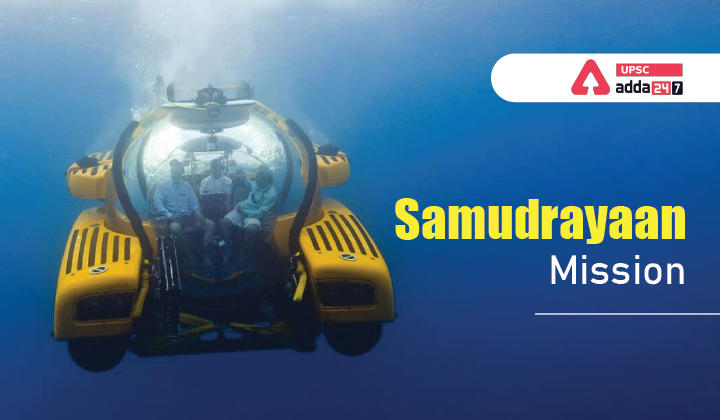Table of Contents
Samudrayaan Mission: Samudrayaan Project is India’s first manned ocean mission launched with an aim to better understand ocean ecology by having niche technology and vehicles to carry out subsea activities. Samudrayaan Project is also important for UPSC Prelims Exam 2023 and UPSC Mains Exam (GS Paper 3- Science and Technology: Indigenisation of technology in India.)
Samudrayaan Mission in News
Dr. Jitendra Singh, the Union Minister, informed the Rajya Sabha that the Samudrayaan Project was initiated in September 2021 under the Deep Ocean Mission, with a budget of Rs 119 Crores. The total budget allocation, disbursement, and expenditure for the Samudrayaan Project since its inception is Rs 119 cr.
Samudrayaan Project Implementation and Accomplishments
The Minister stated that as for the deep-sea explorations conducted since the Project’s commencement, a preliminary trial of Deep Ocean Exploration for Polymetallic Manganese Nodule at the Central Indian Ocean basin was carried out in December 2022. The trial involved the use of an Autonomous Underwater Vehicle (Ocean Mineral Explorer – 6000 – OMe 6000) to gather geophysical, oceanographic, and seabed information at a depth of 5270 m.
- The Ministry of Earth Sciences (MoES) and the National Centre for Polar and Ocean Research (NCPOR) have amassed extensive oceanographic, geophysical, geological, and biological data from the deep-sea areas around the mid-ocean ridges in the Indian Ocean.
- The objective of the mission was to investigate promising sites for multi-metal hydrothermal sulphides.
- An analysis of the data, as well as the integration and interpretation of the information, unveiled multiple prospective locations of hydrothermal venting and mineralization on the Indian Ocean seafloor.
- Furthermore, the mapping and identification of several previously unknown biological species have also been accomplished.
What is Samudrayaan Mission?
Samudrayaan is India’s first manned ocean mission launched with an aim to better understand ocean ecology by having niche technology and vehicles to carry out subsea activities.
- Mandate: Samudrayaan Mission aims to humans into the deep sea in a submersible vehicle for deep-ocean exploration and mining of rare minerals.
- Parent Ministry: Samudrayaan Mission is a project of Ministry of Earth Sciences under its Deep Ocean Mission Project.
- Protect Timeline: The projected timeline of Samudrayaan Mission is five years for the period 2020-2021 to 2025-2026.
- Parent Mission: Samudrayaan Mission is being implemented as a part of the Rs 6000-crores Deep Ocean Mission.
- National Institute of Ocean Technology (NIOT), an autonomous institute under MoES, is entrusted with the responsibility to develop various technologies related to the Samudrayaan Mission.
- Development of Technology: National Institute of Ocean Technology (NIOT) has developed 6000m depth rated Remotely Operated Vehicle (ROV) and various other underwater instruments for the exploration of deep sea, such as-
- Autonomous Coring System (ACS),
- Autonomous Underwater Vehicle (AUV) and
- Deep Sea Mining System (DSM)
- Significance: The manned submersible will allow scientific personnel to observe and understand unexplored deep sea areas by direct interventions.
- Further, it will enhance the capability for deep sea man rated vehicle development.
MATSYA 6000- Technology Development under Samudrayaan Mission
- Submersible Vehicle: Samudrayaan Mission aims to develop a self-propelled manned submersible to carry 3 human beings to a water depth of 6000 meters in the ocean with a suite of scientific sensors and tools for deep ocean exploration.
- It has an endurance of 12 hours of operational period and 96 hours in case of emergency.
- MATSYA 6000: It is an indigenously developed manned submersible vehicle that will send three persons to a depth of 6000 metres into the sea for deep underwater studies.
- Significance: It will help in conducting deep sea exploration of various valuable resources such as-
- Gas hydrates,
- Polymetallic manganese nodules,
- Hydro-thermal sulfides, and
- Cobalt crusts



 TSPSC Group 1 Question Paper 2024, Downl...
TSPSC Group 1 Question Paper 2024, Downl...
 TSPSC Group 1 Answer key 2024 Out, Downl...
TSPSC Group 1 Answer key 2024 Out, Downl...
 UPSC Prelims 2024 Question Paper, Downlo...
UPSC Prelims 2024 Question Paper, Downlo...




